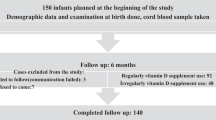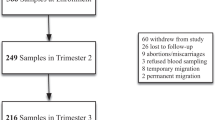Abstract
Objective:
To determine folates, vitamin B12 and total homocysteine levels among neonates from mothers of low or high socioeconomic status.
Design:
We carried out a cross-sectional transversal study comprising 143 neonates from two maternity hospitals in the city of Salvador, Northeast of Brazil. Cord blood samples were obtained at the time of delivery from newborns from low (group 1, n=77) or high (group 2, n=66) socioeconomic status. The vitamin B12 and folates were analyzed by electrochemiluminescence immunoassay and by a competitive test using a natural folate-binding protein (FBP), respectively. Total homocyteine levels were measured by fluorescence polarization immunoassay. Maternal environmental risk factors for pregnancy complications were obtained from all mothers.
Results:
Only 2% of women from group 1 received prenatal care/vitamin supplementation, whereas almost all mothers from group 2 (96%) were properly followed. Anemia and/or infections pre- or during pregnancy was more prevalent among mothers of babies from group 1. Folate levels among newborns from group 1 and 2 were 7.38±2.71 and 8.83±4.06 ng/ml, respectively. No difference in the vitamin B12 levels was determined between groups. In addition, tHcy serum levels were higher among newborns from group 1 compared to those from group 2 (8.54±4.06 vs 6.35±1.33 μmol/l, respectively; P=0.005).
Conclusion:
These results demonstrate that unprivileged young woman has limited accesses to prenatal care, present high-risk factors that hamper both maternal and newborn health. Maternal and newborn health status could be improved by simply reinforcing the use of folate-enriched diet. The work presented illustrates the challenges that developing countries have to face in order to provide preventive adequate health care to the population at large.
This is a preview of subscription content, access via your institution
Access options
Subscribe to this journal
Receive 12 print issues and online access
$259.00 per year
only $21.58 per issue
Buy this article
- Purchase on Springer Link
- Instant access to full article PDF
Prices may be subject to local taxes which are calculated during checkout


Similar content being viewed by others
References
Alessio AC, Annichino-Bizzacchi JM, Bydlowski SP, Eberlin MN, Vellasco AP, Hoehr NF (2004). Polymorphism in the methylenetetrahydrofolate reductase and methionine synthase reductase genes and homocysteine levels in Brazilian children. Am J Med Genet A 128, 256–260.
Anderson JL, Jensen KR, Carlquist JF, Bair TL, Horne BD, Muhlestein JB (2004). Effect of folic acid fortification of food on homocysteine-related mortality. Am J Med 116, 158–164.
Azevedo ES, Silva KMC, Silva MCBO, Lima AMVMD, Fortuna CMM, Santos MG (1981). Genetic antropological studies in the island of Itapacrica, Bahia, Brazil. Human Hered 31, 353–357.
Bailey LN, Rampersaud GC, Kauwell GPA (2003). Folic acid supplements and fortification affect the risk for neural tube defects, vascular disease and cancer: evolving science. J Nutr 133, 1961S–1968S.
Barker DJP (1995). Fetal origins of coronary heart disease. BMJ 311, 171–174.
Bruinse HW, van den Berg H (1995). Changes of some vitaminlevels during and after normal pregnancy. Eur J Obstet Gynecol Reprod Biol 61, 31–37.
Campbell BA (1995). Megaloblastic anaemia in pregnancy. Clin Obstetr Gynecol 38, 455–462.
Couto FD, Adorno EV, Menezes JF, Moura Neto JP, Rego MA, Reis MG et al. (2004). C677T polymorphism of the MTHFR gene and variant hemoglobins: a study in newborns from Salvador, Bahia, Brazil. Cad Saude Publica 20, 529–533.
Czeizel AE, Dudás I (1992). Prevention of the first occurrence of neural-tube defects by periconceptional vitamin supplementation. N Engl J Med 327, 1832–1835.
Fowler B (2005). Hocysteine: overview of biochemistry, molecular biology, and role in disease processes. Semin Vasc Med 5, 77–86.
Girelli D, Frisco S, Trabetti E, Oliveiro O, Russo C, Pessetto R et al. (1998). Methlenetetrahydrofolate reductase C677T mutation, plasma homocysteine, and folate in subjects from northern Italy with or without angiographically documented severe coronary athero-sclerotic disease: evidence for an important genetic-environmental interaction. Blood 91, 4158–4163.
Goldenberg RL, Andrews WW (1996). Intrauterine infection and why preterm prevention programs have failed. Am J Public Health 86, 781–783.
Graham IM, O'Callaghan P (2000). The role of folic acid in the prevention of cardiovascular disease. Curr Opin Lipidol 11, 577–587.
Green R, Miller JW (2005). Vitamin B12 deficiency is the dominant nutritional cause of hyperhomocysteinemia in a folic acid-fortified population. Cin Chem Lab Méd 43, 1048–1051.
Guerra-Shinohara EM, Paiva AA, Rondo PHC, Yamasaki K, Terzi CA, D'Almeida V (2002). Relationship between total homocysteine and folate levels in pregnant women and their newborn babies according to maternal serum levels of vitamin B12. Br J Obstet Gynaecol 109, 784–791.
Johnson IT (2004). Micronutrients and cancer. Proc Nutr Soc 63, 587–595.
Kumar S (1982). Fetal alcohol syndrome: mechanism of teratogenesis. Ann Clin Lab Sci 12, 254–257.
Lambers DS, Clarke KE (1996). The maternal and fetal physiologic effects of nicotine. Semin Perinatol 20, 115–126.
Ladipo OA (2000). Nutrition in pregnancy: mineral and vitamin supplements. Am J Clin Nutr 72, 280–290.
Mansoor MA, Seljeflot I, Arnesen H, Knudsen A, Bates CJ, Mishra G et al. (2004). Endothelial cell adhesion molecules in healthy adults during acute hyperhomocysteinemia and mild hypertriglyceridemia. Clin Biochem 37, 408–414.
Mathews F, Youngman L, Neil A (2004). Maternal circulating nutrient concentrations in pregnancy: implications for birth placental weights of term infants. Am J Clin Nutr 79, 103–110.
McArdle HJ, Ashworth CJ (1999). Micronutrients in fetal growth and development. Br Med Bull 55, 499–510.
McGaw T (2002). Periodontal disease and preterm delivery of lowbirth-weight infants. J Can Dent Assoc 68, 165–169.
Minet JC, Bissé E, Aebischer CP, Beil A, Wieland H, Lütschg J (2000). Assessment of vitamin B12, folate, and vitamin B6 status and relation to sulfur amino acid metabolism in neonates. Am J Clin Nutr 72, 751–757.
Nieuwenhuis RA (2003). Summary of the report. Nutrition Deficiencies in the Netherlands. http://www.soe.nl/nutrepor.htm.
Oakley JP, Adams Jr MJ, Dickinson CM (1996). More folic acid for everyone, now. J Nutr 126, 751S–755S.
Pardo J, Peled Y, Bar J, Hola M, Sela BA, Rafaeel ZB et al. (2000). Evaluation of low serum vitamin (B12) in the non-anaemic pregnant patient. Hum Reprod 15, 224–226.
Picker JD, Coyle JT (2005). Do maternal and hocysteine levels play a role in neurodevelopmental processes that increase risk for schizophrenia? Harv Rev Psychiatry 13, 197–205.
Pippard MJ (1994). Megaloblastic anaemia: geography and diagnosis. Lancet 344, 6–7.
RIIS (Rede Interagencial de informação para a Saúde) (1997). Indicador e Dados básicos. IDB97. Ministério da Saúde: Brasil.
Romero R, Oyarzun E, Mazor M, Sirtori M, Hobbins JC, Bracken M (1989). Meta-analysis of the relationship between asymptomatic bacteriuria and preterm delivery/low birth weight. Obstet Gynecol 73, 576–582.
Spencer CGC, Martin SC, Felmeden DC, Blann AD, Beevers GD, Lip GYH (2004). Relationship of homocysteine to markers of platelet and endothelial activation in ‘high risk’ hypertensives: a substudy of the Anglo-Scandinavian Cardiac Outcomes Trial. Int J Cardiol 94, 293–300.
Smithells RW, Sheppard S, Wild J, Schorah CJ (1989). Prevention of neural tube defect recurrences in yorkshire: final report. Lancet 2, 498–499.
Thomson A (1978). Alcohol and nutrition. Clin Endocrinol Metab 7, 405–428.
Ueland PM, Refsum H, Stabler SP, Malinow MR, Andersson A, Allan RH (1993). Total homocysteine in plasma or serum: methods and clinical applications. Clin Chem 39, 1764–1779.
Verhoef P, de Groot LC (2005). Dietary determinants of plasma homocysteine concentrations. Semin Vasc Med 5, 110–123.
Villar J, Belizan JM, Fischer PJ (1983). Epidemiologic observations on the relationship between calcium intake and eclampsia. Int J Gynaecol Obstet 21, 271–278.
WHO (2002). Improving child health in the community. WHO/FCH/CAH/02 12, WHO: Geneva.
William JW, Beutler E, Erslev AJ, Lichtman MA (1995). Hematology 5th edition McGraw-Hill: New York.
Acknowledgements
We are grateful to all the subjects who participated in this study and for the nurses and physicians who provided the cord blood samples. We thank Lucio Borba from the Roche Laboratory (Salvador-Bahia) for providing the folate and vitamin B12 kits. Research Grant Support: CNPq (306524/2004-0 to MSG), FAPESB (1431030005540 to MSG), Brazilian Department of Healthy (3111 to MSG).
Author information
Authors and Affiliations
Corresponding author
Rights and permissions
About this article
Cite this article
Couto, F., Moreira, L., dos Santos, D. et al. Folate, vitamin B12 and total homocysteine levels in neonates from Brazil. Eur J Clin Nutr 61, 382–386 (2007). https://doi.org/10.1038/sj.ejcn.1602528
Received:
Revised:
Accepted:
Published:
Issue Date:
DOI: https://doi.org/10.1038/sj.ejcn.1602528
Keywords
This article is cited by
-
Adherence to Mediterranean diet during pregnancy and serum lipid, lipoprotein and homocysteine concentrations at birth
European Journal of Nutrition (2015)
-
Cord-blood lipoproteins, homocysteine, insulin sensitivity/resistance marker profile, and concurrence of dysglycaemia and dyslipaemia in full-term neonates of the Mérida Study
European Journal of Pediatrics (2013)
-
The effect of folinic acid supplementation on homocysteine concentrations in newborns
European Journal of Clinical Nutrition (2010)



